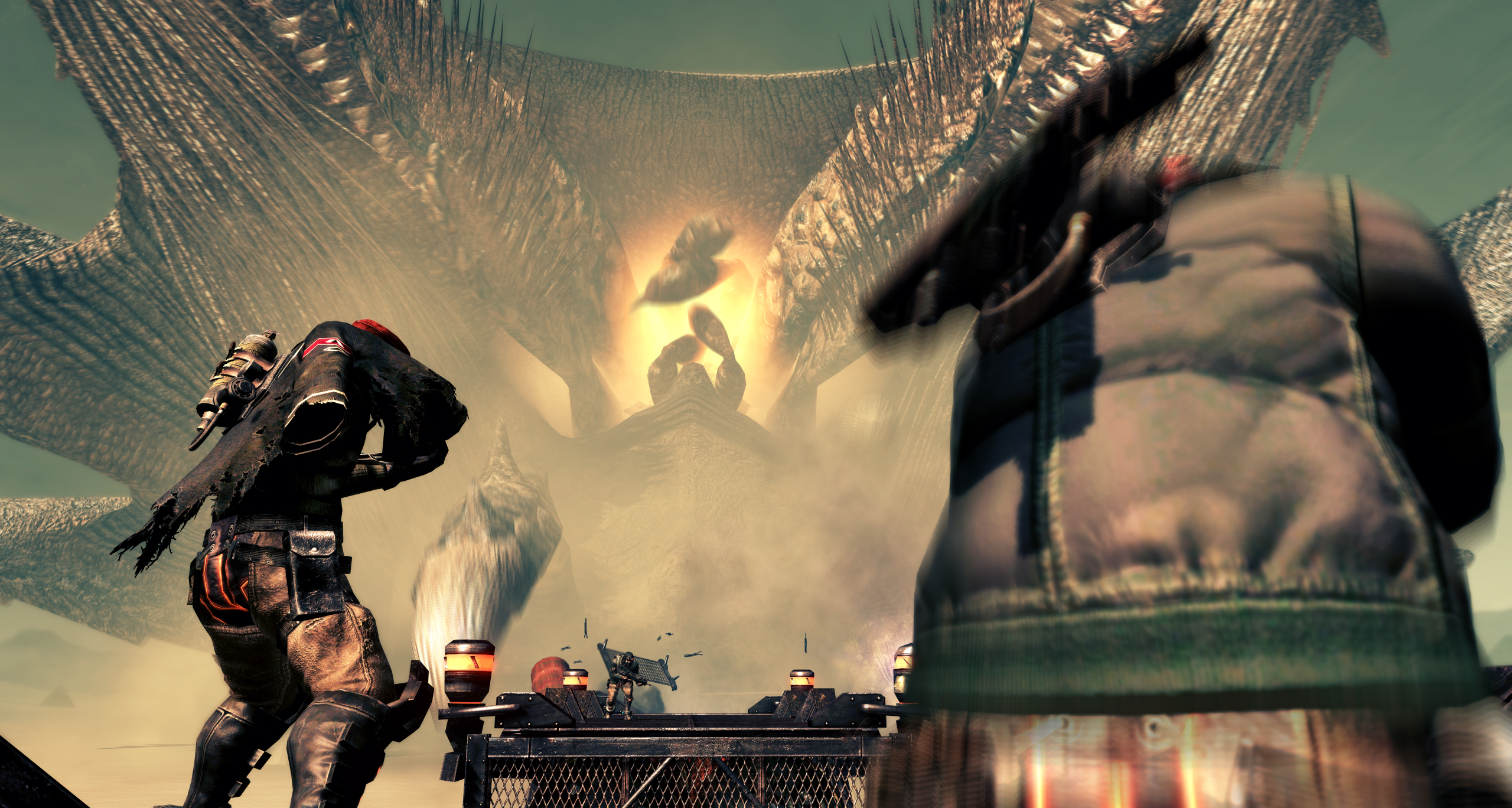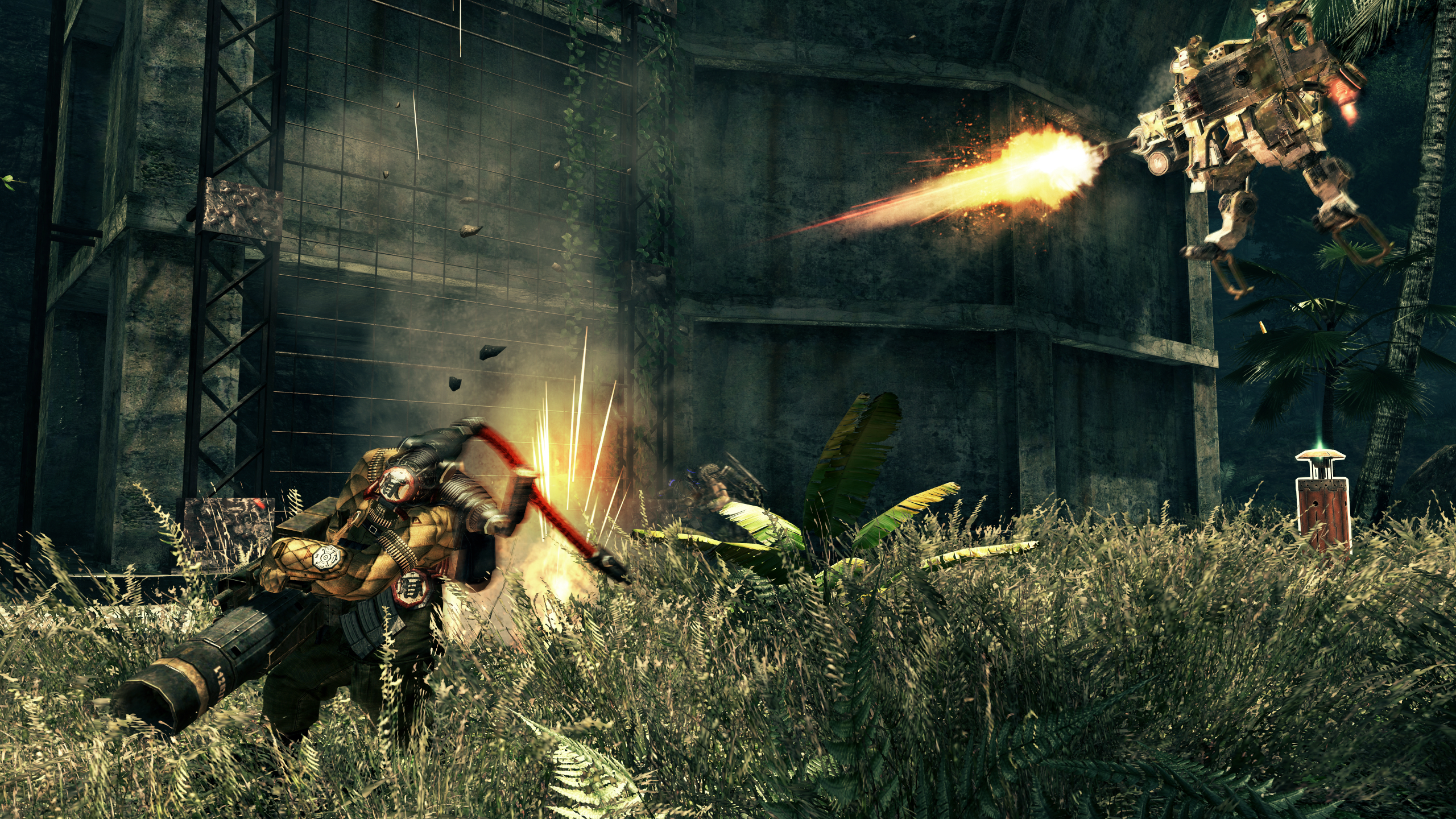Lost Planet 2 is a divisive game. When I write that, I don’t mean that it divides players in any way. I’m using the term to describe the very ideas at the game’score. The game feels like two schools of game design are at war with each other and when the dust settles, what’s left is a game that has moments of brilliance and pure enjoyment, but is hampered by an old way of thinking and numerous technical issues resulting from that.
I would be lying if I said that I didn’t have fun with Lost Planet 2. In fact, I had a lot of fun playing the game, be it with friends, random people online, or by myself. But the main issue that constantly arose was when the gameplay was over, and I was placed back in the confines of the game’s menu, lobby system, and progression system, the experience began to crumble.
Lost Planet 2 places you back on E.D.N. III, the snowy wasteland planet from the first game. Yet, instead of the snow covered landscape of old, 12 years and a whole lot of terraforming have turned the planet into one of lush jungles and barren deserts. This is mostly an excuse to change the landscape up and produce new levels, and it’s a welcome excuse. As far as the story goes, the game’s yarn is practically non-existent. It deals with six warring factions on the planet that each have their own agenda and purpose. Each episode deals with a faction and is divided up into chapters that tell their side of the war.

But don’t expect any sort of continuity or memorable characters. Almost every character that you control has their faces and identity shrouded by headgear and masks. I suppose this is to make it more believable that you and your friends are filling the roles you see onscreen, as the entire campaign can be played cooperatively. This campaign, though, is the first battleground of the warring ideas I mentioned earlier. The single-player "levels," if they could be called that, are built from the ground up for a co-op team. They are wide-open spaces with plenty of geometry to climb, flank, and use as cover. Your objectives are usually simple, like getting from one end of the level to the other or activating data posts. Other levels, though, play like multiplayer arenas where you and your team need to hold out and keep claimed data posts. No level in the campaign feels like something of substance. When compared to something like Gears of War (which is apt because Marcus and Dom are playable characters), the campaign Capcom crafted feels more like a Monster Hunter game and less a competent co-op action game like the Gears franchise. But whereas a game like Monster Hunter Tri is built to be a slow, deliberate experience where you are hunting your prey, Lost Planet 2 feels like the eastern way to make a western shooter and it doesn’t work well.
It’s a real shame because the campaign has some absolutely amazing levels that you shouldn’t miss. I can’t think of any other game that does what Lost Planet 2 does. Fighting Category G Akrids, massive boss monsters that tower over you, is a blast. They require intense teamwork and teammates must jump to higher ground, acquire powerful weapons, or even command the robot VS suits (some of which have more than one seat for other players) to take them out. Another level that comes to mind involves a Category G and a giant rail gun that takes four people to control. I don’t want to spoil it, but it was an experience unlike any other.
Multiplayer follows much of the same pattern. There are standard online modes like Team Deathmatch and Capture the Flag, but with Lost Planet themes, like Capture the Akrid Egg. There is also a more expanded, persistent Faction Mode where you join one of the six factions and are then presented with daily online battles. Pie graphs show who is winning their respective battles each day. It’s a good way to keep you coming back every day if you wish, but there was nothing more than the pie graph data to keep a player tied to the mode. In general, while the multiplayer is enjoyable and varied enough, it is ultimately forgettable and overly frustrating thanks to the game’s myriad of technical issues and bizarre game design choices.

First off, there is no host migration. This means if you’re playing an online co-op game and the host decides to leave or they are disconnected, everyone is booted back to the main menu. You lose all progress and have to redo the chapter. Same goes for online multiplayer. If the host drops, the game ends and you’re booted back. The lobby system even requires a minimum number of players in order to even start the game, which makes it take a while to get a game together. For a game that is shoving its online function down your throat in every gametype, it should have flawless netcode to back it up.
The game’s design problems are even more pronounced than just its online failings. The controls are a bad idea all by themselves. Buttons do double, sometimes triple duty. In order to evade, you have to click in the right thumb stick, push a button, and then point the direction you want to roll. You stop when you switch weapons instead of just running right on. You have to push two buttons to drop a weapon and another two to switch to your healing gun. The game never lets you know what you can and cannot latch onto with your grappling hook, and you have to shoot it unreasonably precisely in order to climb to another surface. Miss and you’ll be caught simply hanging or in harm’s way.
I have to reserve a special section just for the character progression. It starts off as a great idea in that your character levels up no matter what mode you play: solo, co-op, or multiplayer. The problem though, is how you unlock equipment. You gain credits for beating bosses and essentially playing the game. You then use these credits in a slot machine that is populated with not just new weapons and perks, but with emotes and titles. So you can play the game for a few hours, get enough credits to play the slots, and walk away with a waving emote or a useless title. Not new, more powerful guns or a skill that can keep you competitive online, but an emote.
It is eveident that Capcom poured a lot of resources into this game. The environments, enemy Akrids, and characters all look spectacular. The MT Framework engine is at 100% here and it’s one of the most stunning games released this generation. The cutscene direction is action-packed and fun and even the writing is leagues better than the first game. It’s just a wonder where the rest of those resources went.
Lost Planet 2 is a good example of eastern vs. western game design philosophy. It’s a game trying to appeal to western audiences as an action-packed online shooter, but gets hung up on typically eastern design choices that clash with its overall goal. Bad game design, technical issues, and a botched character progression system lead to a game that feels like it’s trying prevent you from having any of the fun that would be possible with four people playing together, taking out skyscraper-tall bug monsters.


















